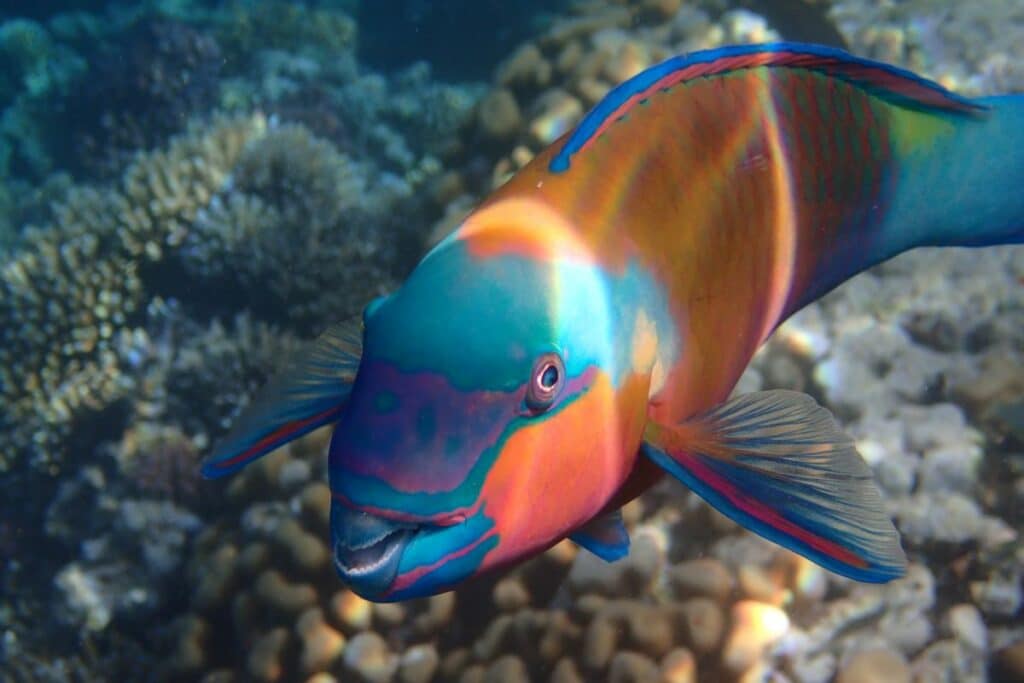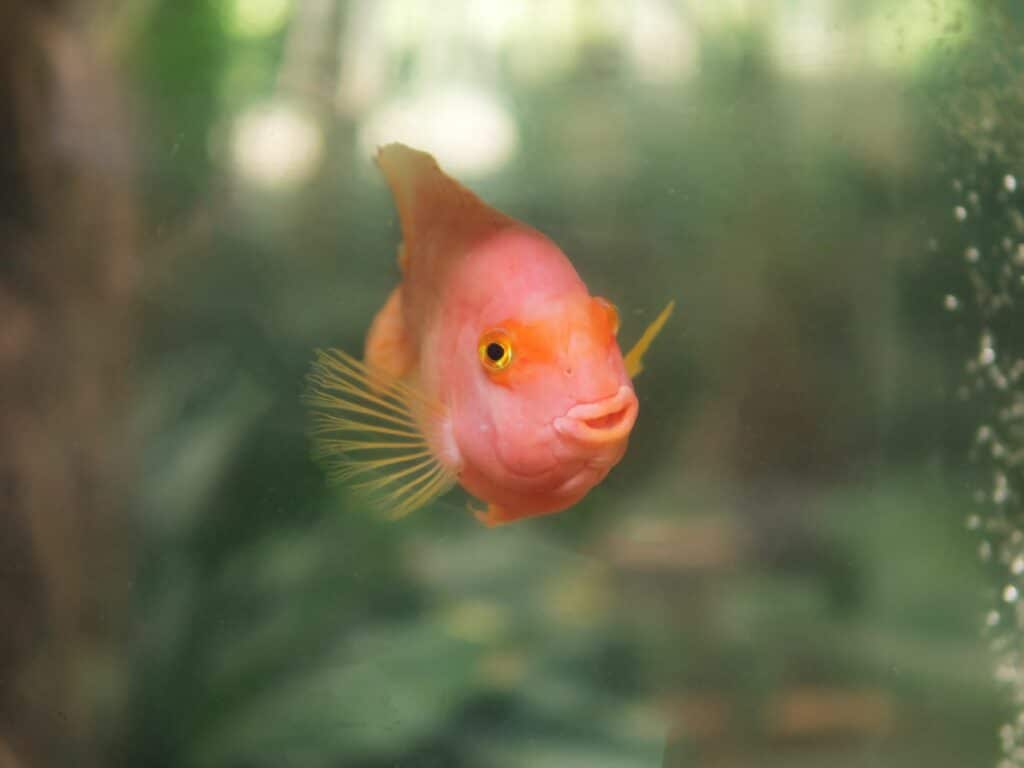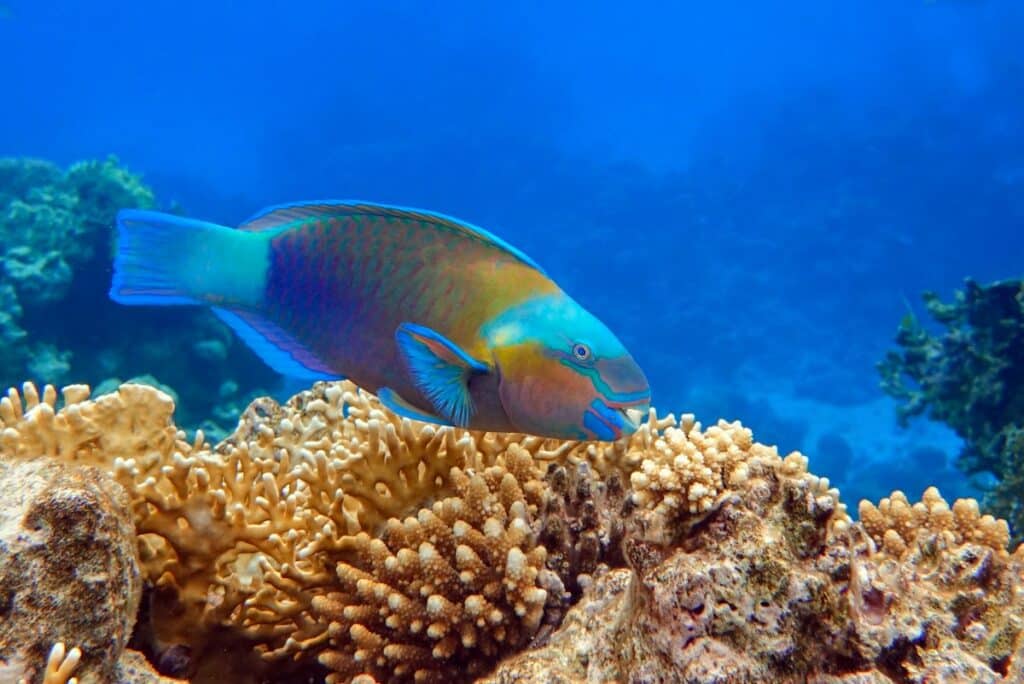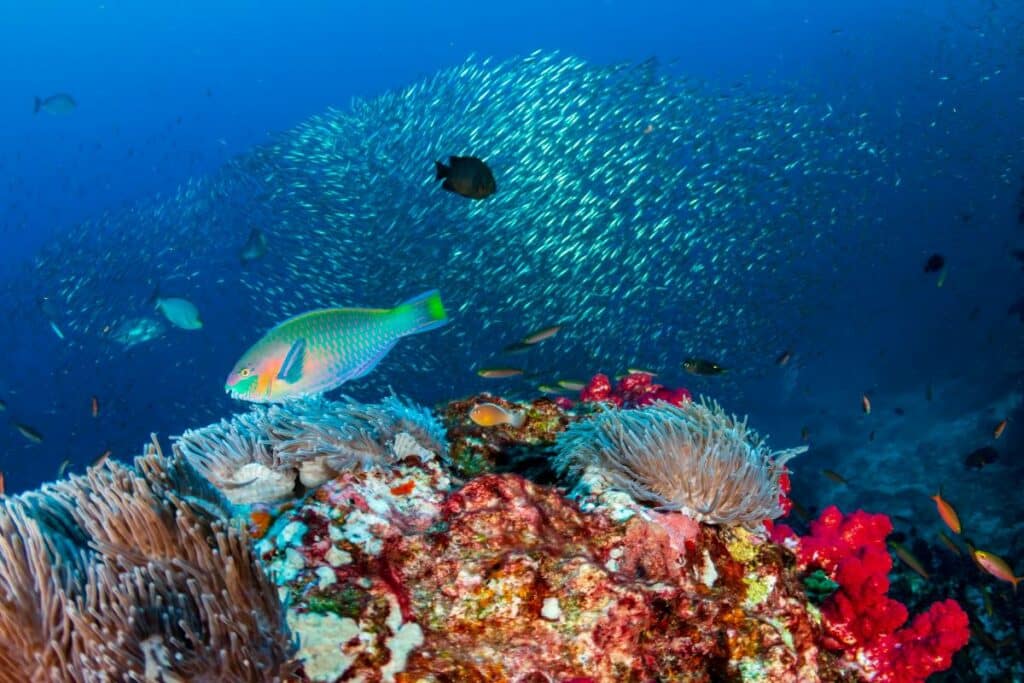the essentials in brief
The parrotfish lives mainly in the Indo-Pacific. We explain here how you keep him in the aquarium.
Parrotfish need a lot of space in the aquarium - at least 500 liters. You can find out how they reproduce here.
The colorful species of fish eats coral and then eliminates the light-colored sand that holidaymakers appreciate so much.
Welcome to the colorful and fascinating world of parrot fish! Their bright colors and eye-catching patterns make them the most dazzling aquarium inhabitants. If you are enthusiastic about exotic sea creatures, you will be captivated by the parrot fish. We will tell you more about their habitats, their husbandry and reproductive strategies.
Exotic colorful sea creatures

key fact box
The parrotfish's striking colors and patterns are used not only for beauty, but also for camouflage and communication with one another.
Parrotfish, also known as parrotfish, belong to Wrasse family (Labridae) and are a diverse group of tropical marine fish. They are characterized by their vibrant coloring and eye-catching patterns reminiscent of the colorful feathers of parrots, hence their name.
These fascinating creatures are equally popular among divers and aquarists, and their diversity, behaviors, and habitats make them interesting research objects for marine biologists.
They are medium to large in size, with a body length of about 20 to 60 centimeters, depending on the species. Their body shape is elongated and flattened laterally, which allows them good maneuverability when swimming.
Her most distinctive feature is undoubtedly hers lively coloring. Most species are colored in various shades of blue, green, red, and yellow, and often have distinctive patterns, stripes, or dots.
An interesting feature of the parrotfish is their ability to to change color. They can change their color patterns in certain situations to suit their mood, dominance or even hers sex readiness to signal.
Habitat and diet of the parrotfish
Parrotfish live mainly in the tropical and subtropical waters of the Indo-Pacific, where they inhabit a variety of habitats. They are often found in coral reefs, lagoons and rocky stretches of coastline as these environments are rich in food and hiding places. Some species prefer shallow coastal waters while others are found in deeper reefs.
Parrotfish are found in various countries along the Indo-Pacific because their range spans a vast geographic region extends. Here are some of the countries where parrotfish are found:
- Indonesia
- Philippines
- Australia
- Maldives
- Fiji
- Thailand
- Hawaii
- Tanzania

This is just a small sampling of the countries where parrotfish can be found. However, their range extends over a much larger region and includes many more countries along the shores of the Indo-Pacific.
In terms of depth distribution, parrotfish can be found in water bodies from a few meters to several hundred meters. Your ability to adapt to different Environmental conditions adapting has contributed to their wide spread and adaptability.
The colorful fish are omnivorous and prefer one varied diet. They feed mainly on algae, but also on small invertebrates such as crustaceans, molluscs and small fish.
your teeth are specialized to hard coral structures gnaw and grate algae from the reefs. This process is important to keep coral reef ecosystems in check, as an overpopulation of algae could affect coral growth.
Additional information: Digesting the algae causes parrotfish to excrete sand and broken coral. This so-called "fish droppings" is rich in calcium carbonate, a main component of coral, and contributes to the formation of coral sand.
Parrotfish reproduction
Parrotfish reproduce by laying eggs and their brood in the care of the male give. This reproductive process can vary by species and habitat, but generally it goes through the following stages.
At breeding time, the males often lead complex courtship dances and color changes through to attract the attention of the females. They display their splendor and dominance to present themselves as suitable partners. When a female shows interest, mating occurs.
After successful mating, the female lays one large number of tiny eggs away. These eggs are usually sticky and stick to a suitable surface in the aquarium or in the natural reef environment.
After the eggs are laid, that's often what it is male, the the brood care takes over. It guards the eggs and defends them against possible predators. During this time, the male does not usually eat and remains close to the eggs to protect them.
A few days to weeks later, depending on the species, the larvae hatch from the eggs. This Larvae are tiny and float freely in the water. They are not well developed yet and need to settle down first feed on their yolk sac.
The larvae go through a phase in which they actively hunt for plankton and evolve. Over time, they undergo metamorphosis, changing shape and evolving into a younger, more fish-like form.
Young parrotfish must now survive and fend for themselves protect against predators. At this stage they are still relatively small and need to strengthen their survival skills.
This reproductive process can anspruchsvoll be and be strong of the Environmental conditions, especially the water quality and the habitat conditions. It is therefore important to be attentive and sensitive when breeding and rearing these fascinating fish species.
keeping parrot fish

If you want to keep parrotfish in an aquarium, there are a few important things to consider to ensure they feel comfortable in their artificial environment develop and feel good.
Because parrotfish are among the larger species of fish, they require a spacious aquarium. Aim for a size of at least 500 liters or more enough swimming space to bid for them.
The water quality is also crucial for the well-being of the fish. Make sure the water is clean and well-aerated. Regular partial water change is important to reduce pollutants in the water.
Parrotfish are native to tropical and subtropical waters, so it is important to keep the aquarium water at a stable temperature between 24°C and 28°C to keep. Depending on the species of parrotfish, the salinity of the water can also be adjusted.
Provide enough structure in the aquarium to accommodate the fish hiding places to offer. Coral reef-like decorations, caves, and rock structures are useful to give the fish a sense of security.
Tip: Use appropriate lighting that mimics the natural spectrum of light and brings out the colors of the fish. The lighting should also simulate a day-night rhythm.
Parrotfish need one varied diet. Offer them high-quality flake food, pellets and frozen foods such as Mysis, Artemia or Krill. In addition, they can also enjoy vegetables and seaweed leaves.
Make sure you compatible fish species hold together Some parrotfish can territorial be, so it is important to make species selection carefully to avoid conflicts.
hold that Aquarium cleanby removing dead plant matter and excess food. Regularly monitor water parameters and perform water changes as needed.
Tip: Research the specific requirements of the parrotfish species you wish to keep. Different species can have different needs, so it's important to do your research beforehand.
Keeping parrotfish in the aquarium can be a rewarding experience, but it requires it diligence and commitmentto create an optimal environment for these colorful and fascinating fish. If you ensure the right conditions, they will surely delight you with their beauty and interesting behavior.
Parrotfish: Magnificent colors and variety in the aquarium
The variety of parrot fish is incredible, and theirs adaptability to different habitats is admirable. From shallow reefs to deep waters of the Indo-Pacific to aquariums, they have evolved into true survivors.
As algae eaters, they play a crucial role in maintaining the balance in coral reefs. Their contribution to controlling algal growth promotes coral health, which is vital to the maintenance of these impressive ecosystems.


